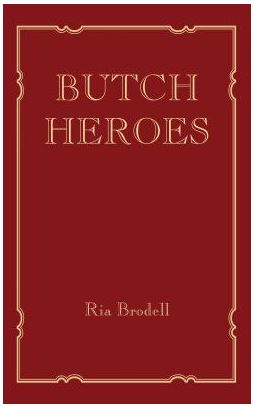 Brodell, Ria. Butch Heroes. MIT Press. 2018. $24.95. 96p. Hardcover. 9780262038973.
Brodell, Ria. Butch Heroes. MIT Press. 2018. $24.95. 96p. Hardcover. 9780262038973.
Butch Heroes combines fine art and a kind of LGBTQIAA archaeology. Artist Ria Brodell sifted through historical documents to find the stories of individuals who, — to paraphrase Brodell — while apparently assigned female at birth, chose a gender presentation that was more masculine than feminine, and had documented relationships with women. Each individual is portrayed with a portrait in the style of a Catholic holy card, and each portrait is accompanied by a brief biography. A bibliography at the back of the book records the sources Brodell used to compile the biography; they attempted to find original sources from the time, such as newspaper articles or personal journal entries, whenever possible.
The result is a fascinating and tantalizing glimpse at complicated lives, and a powerful reminder that gender nonconformity and diverse sexual orientations are not confined to the modern age. Because individuals in the past did not have had terms and concepts for themselves such as “lesbian,” “transgender,” “genderqueer,” “nonbinary,” or indeed “butch,” there is often reluctance on the part of historians to treat people like those portrayed in this book as part of our shared queer history. However, this reluctance can lead to the erasure of non-conforming lives like those celebrated herein. We don’t know how any of these people would identify, were they alive today, but we can look to their stories and recognize the shared threads.
Given how little is known about how they would have identified, Brodell makes some interesting choices in terms of pronoun use in this book. They write, “To determine pronoun use, I refer to their gender presentation or chosen name at each point in their story. If it is uncertain, I use ‘she or he,’ ‘him/her,’ ‘they,’ or just their name(s).” Some readers might find this changeability maddening, but I found it to be an effective and poetic technique for highlighting the fluid nature of identity, as well as the impossibility of knowing how each individual would have defined themselves.
Reading this book is a bracing experience. Quite a few of the stories are unhappy; a number involve betrayal, imprisonment, public punishment, or even execution. Still, there’s a vibrant kind of cussedness that keeps coming through, even when the person in question met an unhappy end: these were individuals who were bound and determined to live their lives on their own terms. Ultimately, I was left with a feeling of joy and awe. Since it is a somewhat slim volume with a nondescript cover, this is a book that will benefit from “handselling” on the part of library staff in order to find its audience. I would recommend it to all public and academic library collections, particularly where there is an interest in portraiture.
Kirsten Brodbeck-Kenney
[…] Butch Heroes by Ria Brodell was reviewed at ALA GLBT Reviews. […]